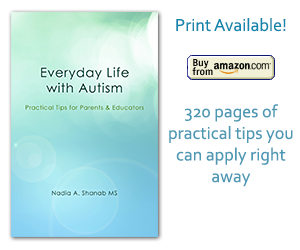By Nadia Shanab | autism
This is one of the largest and comprehensive studies/researches done on individuals (2 million) with ASD. Everyday researchers are getting closer to identify the causes of autism. So far, we have been saying that the major causes of autism are genetic factors, environmental factors, or a combination of both. The recent research (published May 4, 2014)
Tags: autism, communication, environmental, gender, genetics, health, heritability, latest research, risk factors
Posted in autism | Comments Off on Revolutionary Findings: Genetic and Environmental Factors are Equally Important Risk Factors
By Nadia Shanab | autism
April, the autism awareness month, is back! This is a perfect opportunity to express my hopes and emotions regarding autism in our daily life. I hope one day people reach the point of accepting all individuals with autism the way they are. According to the CDC, the prelevance has jumped to one child in sixty-eight
Tags: asperger's syndrome, autism, communication, flexibility, independence, parenting, research, tips
Posted in autism | Comments Off on “I Have A Dream”
By Nadia Shanab | autism
The reason of autism has not been found yet as we talk. However, the number of children diagnosed with autism is on the rise. The question will ramain: Is it because doctors can better diagnose it now? Or it is actually the real number of children born with autism is increasing? According to the CDC
Tags: asperger's syndrome, autism, communication, discipline, early intervention, health, independence, parenting, research, social interaction, symptoms of autism, tips
Posted in autism | Comments Off on Number of Cases of Autism Is on The Rise
By Nadia Shanab | autism
Source: Children’s Hospital& Research Center Oakland. “Researchers show that seotonin, oxytocin, and vasopressin, three brain hormones that affect social behavior related to autism, are all activated by vitamin D hormone. Supplementation with vitamin D and tryptophan would be a practical and affordable solution to help prevent autism and possibly ameliorate some symptoms of the disorder.”
Tags: autism, communication, health, research, social interaction, tips
Posted in autism | Comments Off on Low Level of Serotonin and Vitamin D Linked to Autism
By Nadia Shanab | Uncategorized
The fundamnetal requirement for an individual with an autism spectrum disorder to be successful in life after high school is independenc. As repeatedly mentioned before, poor communication and social skills are the two most common traits of autism. Consequently, high school students with autism exhibit difficulty asking questions and expressing themselves. Additionally, their rigidity and
Tags: autism, communication, discipline, early intervention, flexibility, independence, organization, parenting
Posted in Uncategorized | Comments Off on Independence is The Most Important Quality to Teach
By Nadia Shanab | Uncategorized
Facilitating social interaction for children with Autism Spectrum Disorder (ASD) is crucial to help them communicate and connect with the society. In schools, adults should encourage kids with autism to mingle with typically developed peers on the play ground. Luckily, all children enjoy recess and playtime, because it is simply a time to have fun!
Tags: autism, communication, parenting, peer effect, research, social interaction, socialization, tips
Posted in Uncategorized | Comments Off on Peer’s Effect on Children with Autism
By Nadia Shanab | Uncategorized
In a research done by a team of The University of Missouri found a relationship between bedroom access to a telivision or computer and reduced sleep among boys with autism. Besides, they found a relationship between the average video-game exposure and less time sleeping among boys with ASD. Read the full research here. Using a
Tags: asperger's syndrome, autism, communication, health, research, sleep, technology, video games
Posted in Uncategorized | Comments Off on Less Sleep Hours Linked to Bedroom Screens
By Nadia Shanab | Uncategorized
This is the time of the year when most of us tend to look back and try to “evaluate” or “assess” the last twelve months’ achievements. Parents, don’t be harsh on yourself and on your child, we’re human. Before you blame yourself for not meeting all the goals you’ve set a year ago, ask yourself
Tags: asperger's syndrome, autism, communication, consequences, diagnosis, discipline, early intervention, flexibility, health, independence, occupational therapy, organization, parenting, research, social interaction, tips
Posted in Uncategorized | Comments Off on End-of-Year Checklist
By Nadia Shanab | Uncategorized
Often times we see parents of children with ASD (Autism Spectrum Disorders) comparing their child to her peers. They assume that if a peer has been fully mainstreamed and their child is still struggling with one subject in mainstream, they would consider it a failure on their part as well as the child’s. The reason
Tags: asperger's syndrome, autism, cognition, communication, early intervention, mainstreaming, neurodevelopmental conditions, parenting, sensory integration issues, spectrum
Posted in Uncategorized | Comments Off on No Two Individuals with Autism Are The Same
By Nadia Shanab | Uncategorized
A research from the Keck School of Medicine of the University of Southern California was recently published suggesting: “Children with both the risk of autism genotype and exposure to high air polluant levels were at increased risk of autism spectrum disorder compared to those without the risk genotype and lower air pollution exposure.” This study
Tags: air pollution, asperger's syndrome, autism, communication, genetics, neurodevelopmental conditions, parenting, research, symptoms of autism
Posted in Uncategorized | Comments Off on Air Pollution Increases The Risk of Autism

